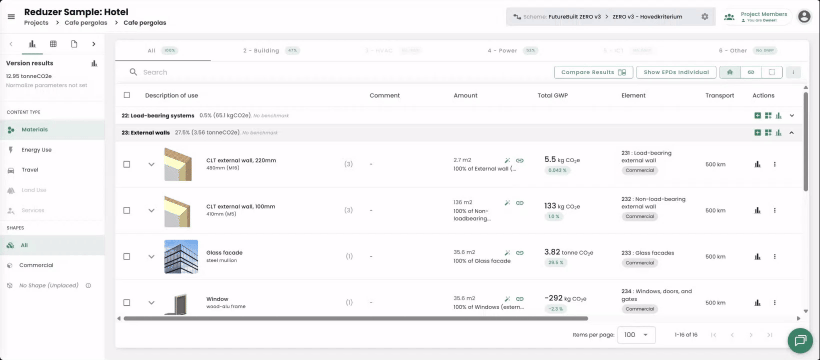Understanding Carbon Footprint Basics
Under development
This page is under development and some information may be missing or inaccurate.
Carbon footprint calculations of buildings and infrastructure, also known as Life Cycle Assessment (LCA), is a way of estimating the greenhouse gas (GHG) emissions that occur due to the construction, operation, and demolition of a product or service. In other words, it's an estimate of the global warming impact of over the entire lifetime of the construction object.
Building LCAs are usually divided into the three phases according to various stardards such as EN 15978
- A: construction
- B: operation
- C: end-of-life (demolition)
According to the standards, each of these phases are again separated into numbered phases, for example A1: extraction of raw materials, A2: transport of raw materials, and A3: manufacturing, and so on.
What is Life Cycle Assessment (LCA)?
Life Cycle Assessment is a methodology to assess the environmental impact of a product/building or service throughout its entire life cycle. The core methodology of LCA is stadardized in ISO 14040/44.
The life cycle is categorized in those phases:
- (A) production + construction
- (B) operational use
- (C) end-of-life
- (D) beyond

It helps measure factors like energy consumption and greenhouse gas emissions.
What are the important elements of a building/infrastructure LCA?
Environmental Product Declaration (EPD)
Reduzer's product and component library is in large parts based environmental information from EPDs.
EPD stands for "Environmental Product Declaration" and is a standardized third-party certified document that provides information about the environmental performance of a product over its entire life cycle. The EPDs are often the main data source for the Life Cycle Assessment (LCA) calculation and offer data to environmental impact categories, such as:
- Global Warming potential (GWP [kgCO2eq])
- Ozone Depletion Potential (ODP [kgCFC11eq])
- PhotochemicalOzoneCreationPotential (POCP [kgC2H4eq])
- AcidificationPotential (AP [kgSO2eq])
- EutrophicationPotential (EP [kgSO2eq])
- Water usage
- Life span
Further reading
Life span
The LCA calculation methods for the life spans of buildings are usually set to 50 or 60 years, in order to be able to compare it with other projects. In other words, the calculation assumes that the building will be demolished after 50 or 60 years (hopefully not in real life!) and calculates all emissions from production, operation to end of life.
Products on the other side might have a shorter life span.
For example photovoltaic panels have a rough service life of 30 years and need to be replaced after that time.
Careful!
The life span is a huge factor that can change the outcome of emissions - be aware! The goal is to use materials which are durable, last longer, and doesn't need to be replaced.
Further reading
How is the calculation done?
You don't have to worry about the calculations, that is taken care of by the software. However, if your are intersted, here is some more information:
Calculation methods (schemes)
There are many different schemes on how to calculate the LCA:
- BREEAM
- TEK17
- NS3720
- FutureBuilt Zero
- DNGB
- ...
Careful!
To be able to compare the results you must always compare the same scheme.
🍀 TIP
With Reduzer you can change the scheme easily with one click.
On most pages you can change the scheme on the top right corner:

Overview of the differences between the schemes

Careful!
Some calculation methods use different life spans. For example, the NS3720 uses 60 years while the german DNGB calculation uses 50 years. This has an big impact on the emission results.

